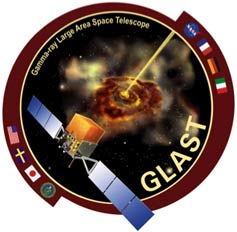
Handy Links
SLAC News Center
SLAC Today
- Subscribe
- Archives: Feb 2006-May 20, 2011
- Archives: May 23, 2011 and later
- Submit Feedback or Story Ideas
- About SLAC Today
SLAC News
Lab News
- Interactions
- Lightsources.org
- ILC NewsLine
- Int'l Science Grid This Week
- Fermilab Today
- Berkeley Lab News
- @brookhaven TODAY
- DOE Pulse
- CERN Courier
- DESY inForm
- US / LHC
SLAC Links
- Emergency
- Safety
- Policy Repository
- Site Entry Form

- Site Maps
- M & O Review
- Computing Status & Calendar
- SLAC Colloquium
- SLACspeak
- SLACspace
- SLAC Logo
- Café Menu
- Flea Market
- Web E-mail
- Marguerite Shuttle
- Discount Commuter Passes
-
Award Reporting Form
- SPIRES
- SciDoc
- Activity Groups
- Library
Stanford
Around the Bay
GLAST: The Challenge of Too Much New Data
 The astrophysics community
enthusiastically awaits the upcoming launch of the Gamma-ray Large Area Space
Telescope (GLAST), the latest and most powerful gamma-ray telescope. But interpreting the huge amount of new data
that GLAST will collect may prove difficult.
The astrophysics community
enthusiastically awaits the upcoming launch of the Gamma-ray Large Area Space
Telescope (GLAST), the latest and most powerful gamma-ray telescope. But interpreting the huge amount of new data
that GLAST will collect may prove difficult.
Until now, existing instruments have allowed astrophysicists to detect about 300 possible sources of gamma-rays in the universe, and scientists have had to analyze and classify these sources one by one. GLAST's increased sensitivity, 30 to 100 times greater than that of its predecessors, will allow the telescope to potentially detect thousands of new sources of gamma rays.
"We'll have a hard time identifying them," says Stanford Physicist Olaf Reimer. "We can't apply the individual approach for thousands of sources anymore. Researchers took 20 years to identify Geminga, the radio-quiet gamma ray pulsar, but we cannot spend 20 years on a single source again."
To address the scientific challenges GLAST will raise, Reimer and several colleagues organized a conference called "The Multi-messenger Approach to High-energy Gamma Ray Sources," which was held last July in Barcelona. This conference was the third in a series exclusively devoted to the problem of gamma-ray source identification. In a book to be published this June, based on the conference, Reimer suggests combining the established identification technique with a population-based statistical approach.
"The idea is to establish the characteristics of the populations hiding in the wells of new data," Reimer says. Then, researchers could proceed to single out the most appropriate candidates for new gamma-ray sources among those populations.
The problem with identifying new populations of gamma-ray sources is that astrophysicists do not know how the sources behave. "We know that active galactic nuclei occasionally flare, pulsars pulse, binaries have characteristic orbits… these are clear signatures," Reimer says. "But for new galactic phenomena, we don't have that knowledge."
Reimer admits this new scientific problem is tough. "But we have to address it, because you can only make science if you know what you're dealing with in the sky," he says.
—María José Viñas, SLAC Today, May 21, 2007